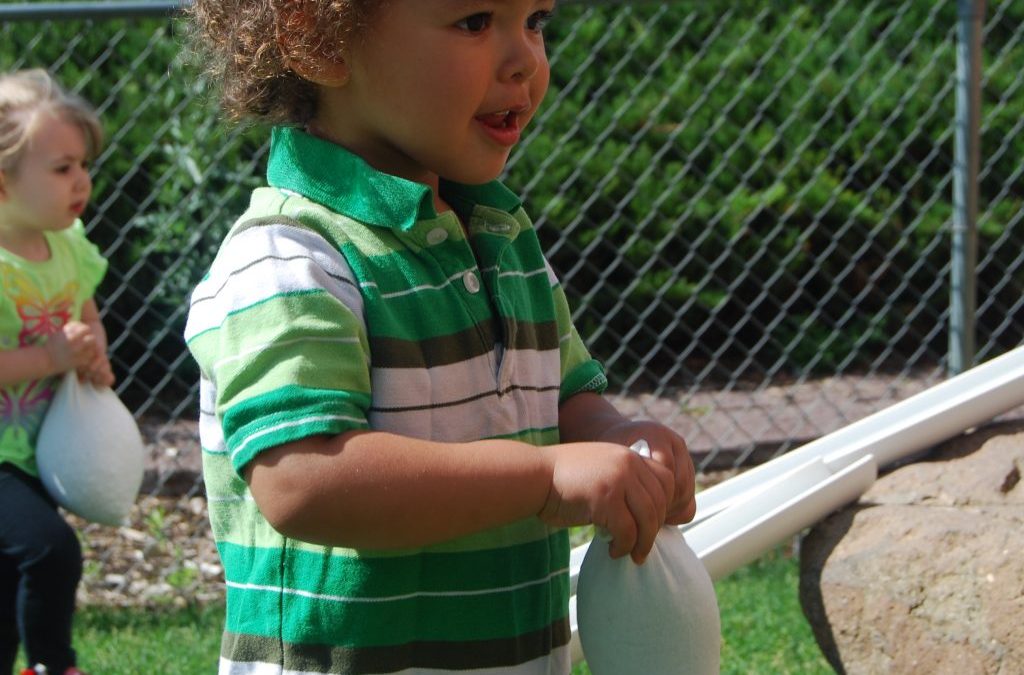Playground Memories
I recently came across a few old photos of my kindergarten playground. The space was basically a concrete pad that featured monkey bars made of pipe, a slide, a painted hopscotch court, and a bench. It didn’t have any vegetable gardens, trees, flowers, sand pits, sensory tables, or natural spaces. It did, however, have a big cart full of balls which were loved by all. I remember getting in trouble for climbing up the ladder of the slide while clutching a playground ball. My plan to send it careening down to see if it would reach the far end of the space was squashed by a well-meaning adult.
Today’s Playground Designs
Unlike those days when outside time was nothing more than recess, today’s early childhood programs recognize that outdoor learning spaces are incredibly valuable for children’s overall well being and development. Spaces for leaping, running, climbing, and chasing balls are now mingled with natural spaces filled with sand, soil, rocks, plants, and trees that offer texture, shade, beauty, and invite exploration of the natural world. The old fashioned pipeworks monkey bars have been replaced with multi-leveled log structures, tree stumps, and rope bridges. Playground designs today include active learning spaces such as outdoor science labs, art studios, farm to table gardens, mud kitchens, grassy hillsides, and materials that invite imagination, collaboration, and problem-solving.
Easy To Implement Ideas
If your program is lacking in natural spaces or cannot undergo a major transformation consider adding planting boxes and potted trees. Arbors and pergolas made of natural timbers or willow branches often provide shade and are perfect for creating focused areas for exploration. Even adding shade sails can set the stage for you to develop a covered area for physics or earth science experiences. If your space does not have access to water, give several children the responsibility of filling up small buckets from indoors to fill shallow bins or sensory tables outdoors.

Chain link fences shared with other classrooms can be used for weaving fabric strips or long grasses, hanging potted plants, or attaching pipes. Fences are also perfect for installing Magnet Walls or water course systems using plastic tubing and funnels. Attach open picture frames to chain link fences or cut peep holes into wooden fences to offer children a specified viewing space for observing animals, people, or vehicles that pass by. Create bird feeding platforms or mini bird baths using plastic food trays and attach those to your fence. Simple additions like these offer children a starting point to explore and investigate, ask questions, and seek out the answers. The formula is pretty simple; for every man-made item you have, add something natural. For every material you have, add tools to explore the material.
Whole Child Learning
Outdoor learning settings naturally provide children with opportunities for social and emotional growth, conversation, vocabulary development and fine and gross motor practice. They can also be spaces in which earth and physical science concepts are explored, where math is integrated in play, and where process skills such as prediction, observation, and problem-solving are central to exploration. Keep in mind that a rich sensory experience should be present in each of your program’s learning spaces, including those you create outdoors.
If your space is or under development or even fully developed, our Enhancing Outdoors curated collections provide a diverse assortment of tools and accessories. I’m proud to be a part of the education and design team behind these terrific products. After all, I was the child who wanted to test how balls would travel down a slide and I’m still experimenting today! In recent months we’ve all been indoors a little too much. It’s time to get outside, refresh our spaces, and recognize all the learning taking place outdoors.


